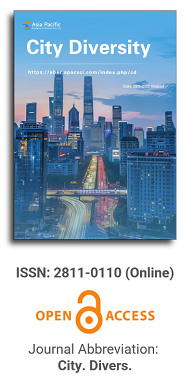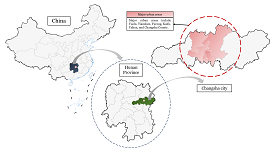
Asia Pacific Academy of Science Pte. Ltd. (APACSCI) specializes in international journal publishing. APACSCI adopts the open access publishing model and provides an important communication bridge for academic groups whose interest fields include engineering, technology, medicine, computer, mathematics, agriculture and forestry, and environment.

As China's pillar industry, the property market has suffered a considerable impact in recent years, with a decline in turnover and many developers at risk of bankruptcy. As one of the most concerned factors for stakeholders, housing prices need to be predicted more objectively and accurately to minimize decision-making errors by developers and consumers. Many prediction models in recent years have been unfriendly to consumers due to technical difficulties, high data demand, and varying factors affecting house prices in different regions. A uniform model across the country cannot capture local differences accurately, so this study compares and analyses the fitting effects of multiple machine learning models using February 2024 new building data in Changsha as an example, aiming to provide consumers with a simple and practical reference for prediction methods. The modeling exploration applies several regression techniques based on machine learning algorithms, such as Stepwise regression, Robust regression, Lasso regression, Ridge regression, Ordinary Least Squares (OLS) regression, Extreme Gradient Boosted regression (XGBoost), and Random Forest (RF) regression. These algorithms are used to construct forecasting models, and the best-performing model is selected by conducting a comparative analysis of the forecasting errors obtained between these models. The research found that machine learning is a practical approach to property price prediction, with least squares regression and Lasso regression providing relatively more convincing results.
Issue release: 31 December 2024
As China’s pillar industry, the property market has suffered a considerable impact in recent years, with a decline in turnover and many developers at risk of bankruptcy. As one of the most concerned factors for stakeholders, housing prices need to be predicted more objectively and accurately to minimize decision-making errors by developers and consumers. Many prediction models in recent years have been unfriendly to consumers due to technical difficulties, high data demand, and varying factors affecting house prices in different regions. A uniform model across the country cannot capture local differences accurately, so this study compares and analyses the fitting effects of multiple machine learning models using February 2024 new building data in Changsha as an example, aiming to provide consumers with a simple and practical reference for prediction methods. The modeling exploration applies several regression techniques based on machine learning algorithms, such as Stepwise regression, Robust regression, Lasso regression, Ridge regression, Ordinary Least Squares (OLS) regression, Extreme Gradient Boosted regression (XGBoost), and Random Forest (RF) regression. These algorithms are used to construct forecasting models, and the best-performing model is selected by conducting a comparative analysis of the forecasting errors obtained between these models. The research found that machine learning is a practical approach to property price prediction, with least squares regression and Lasso regression providing relatively more convincing results.
Issue release: 31 December 2024
The habitat unit in urban fringe is an important link to support regional biodiversity; due to the influence of urban system and agricultural system, most of them are semi natural, appeared with diverse types, small patches, scattered layout, and generally relying on low intensity farming activities. Export-oriented expansion of urban construction land and intensive agricultural production are prone to reduce the scale and quality of semi natural habitats in urban fringe areas; and the existing measures cannot effectively protect them. High natural value farmland management is an effective measure of the EU to protect semi-natural habitats related to agriculture and maintain regional biodiversity. Through combing the main points of high natural value farmland such as type definition, evaluation, identification, maintenance management, etc., this paper proposes the suggestions for optimization of small and micro semi-natural habitat protection in China: (1) strengthening the recognition of the value of small and microhabitats and related land use; (2) identifying small and micro-habitats that are conducive to the maintenance of biodiversity, and incorporating them in the overall protection of regional network; (3) combining the rigidity and flexibility of land use control, with the consideration of complex function demands; (4) Converging with the existing statutory planning to enhance the protection efficiency of small and micro habitats.
Issue release: 31 December 2024
Based on the data samples of 276 cities at prefecture level and above in China from 2000 to 2012, using dialect diversity as a proxy to measure cultural diversity, using random effect model, system generalized moment estimation, two-stage least square method and other methods, this paper conducted an empirical investigation on the impact of cultural diversity on China's urbanization for the first time. It is found that dialect diversity has a significant negative impact on urbanization rate; considering the possibility of missing variables, the influence of dialect diversity on urbanization rate is still significantly negative; after using the historical immigration as the instrumental variable of dialect diversity, this negative influence still exists, but the degree of influence has decreased. Therefore, the cultural variables represented by dialects are an important factor affecting the process of urbanization.
Issue release: 31 December 2024
Measuring the occupational diversity and trend of Chinese cities from the perspective of the distribution of urban occupational types, and discussing the impact of urban characteristics on urban occupational diversity can provide reference for guiding urban full and high-quality employment. By using the improved Herfindahl index, panel data fixed effect model and Oaxaca blinder decomposition, it is found that the occupational diversity in Chinese cities showed a trend of first decreasing and then increasing from 2002 to 2016, which was due to the adjustment of urban industrial structure and the emergence of new economy after the financial crisis; at the same time, the larger the city, the higher the administrative level and the more developed the economy, the higher the degree of occupational diversity. The conclusion of the study is helpful to intuitively understand the occupational distribution, industrial structure and division of labor in different cities, evaluate the human resource structure and economic development potential of cities, and then provide policy suggestions for different cities to formulate industrial development and human resource planning.
Issue release: 31 December 2024
From the perspective of cross regional flow of human capital, this paper studies the impact and mechanism of foreign human capital on urban innovation in China, and reveals the innovation effect of foreign human capital. The theoretical research shows that the efficient allocation of innovation elements brought by foreign human capital and the diversified externalities associated with it are the source for cities to maintain innovation vitality and competitiveness. The empirical study matching the individual micro data of Chinese census with the urban patent data found that foreign human capital has a significant role in promoting urban innovation, especially in the innovation of invention patents with the highest technological content. Further research on the mechanism reveals that the externality of cultural diversity brought by foreign human capital is an important channel to promote urban innovation. Therefore, the absorption and integration of foreign labor is the key to the city full of innovation and vitality.
Issue release: 31 December 2024
China, as a transitional economy, faces a high level of market segmentation among administrative regions, which lowers the efficiency of resource allocation and the total factor productivity (TFP) rate. The literature has focused on the negative effects of local protectionism and administrative division on the formation of market integration in the economic growth process. However, considering that administrative districts such as prefectures usually overlap with cultural regions in China, the effects of local protectionism and administrative division on market segmentation may be overestimated because cultural diversity may also be negatively related to market integration. More importantly, diversity of dialect tends to increase the cost of communication, making it a barrier to labor migration and decreasing the level of generalized trust among people. As a result, it may have adverse effects on the market integration process. Recently, more empirical works have explored the relationship between cultural diversity, which they usually measure as the number of dialects and amount of economic growth in the region, and have generally shown consistent results. For example, a study has shown that dialect diversity has adverse effects on GDP per capita. Another finds that dialect diversity and not genetic differences can explain regional disparities in China to a large extent. Similarly, Scholars indicates that dialect diversity has adverse effects on the productivity of neighboring counties. Nevertheless, to the best of our knowledge, few works reveal the impact of dialect diversity on the level of market segmentation among regions in China. Taking a somewhat different approach, we directly focus on the effects of dialect diversity on market segmentation. Empirically, to estimate the causal effects of dialect diversity on market segmentation, we randomly build the synthetic metropolitan area as the fundamental analysis unit in which a core prefecture borders several other governorates. Consequently, within the artificial metropolitan area, the number of dialects and amount of market segmentation can be measured. Given that the synthetic metropolitan area does not belong to any particular administrative district, the differences in market segmentation between synthetic metropolitan areas are attributed to variations in dialect and other economic or geographic factors rather than the administrative division between areas. Based on the method developed, this paper uses the seven categories of retail prices in prefectures in 2016 to calculate the market segmentation index of each synthetic metropolitan area, which it takes as the dependent variable. Furthermore, this paper constructs a dialect diversity index for each synthetic metropolitan area, which it takes as the key independent variable. The results show that diversity of dialect is a critical factor in lowering the amount of market integration in China. The findings are robust to various checks. Furthermore, this paper takes the number of local theatrical genres as an instrumental variable of dialect diversity. The instrumented estimations show that a one-dialect increase in the synthetic metropolitan area increases the amount of market segmentation by about 2.42%. The amount of market segmentation in the synthetic metropolitan area, which has the average number of dialects, is 8.23% higher than in areas with only one dialect. The empirical results imply that it is essential to weaken local protectionism and enhance cultural integration between regions to decrease market segmentation. This paper makes three contributions to the literature. First, it enriches the broad interpretations of the causes of market segmentation from the dialect diversity viewpoint. Second, it directly estimates the effects of dialect diversity on market segmentation and determines the long-term effects of cultural factors, providing new cultural economics evidence from China. Third, this paper contributes to the literature analyzing the underlying mechanisms behind dialect diversity and growth, suggesting that market segmentation is another mechanism used to understand this causal relationship.
Issue release: 31 December 2024
Employment is the biggest livelihood of the people. What kind of industrial structure is more conducive to employment creation is an important issue for the government to consider when adjusting the industrial structure. Using enterprise and city data, using a spatial dynamic panel model that takes into account both the dynamic change of dependent variables and the spatial spillover effect, and can overcome the endogenous problem between variables, this paper examines the impact of industry-related diversity and unrelated diversity on urban aggregate employment creation. The study finds that both types of diversity are conducive to urban aggregate employment creation, but the role of related diversity is more prominent in comparison. Urban heterogeneity plays an important role in regulating the employment creation effect of industrial diversity. Among them, urban absorptive capacity strengthens the employment creation effect of the two types of industrial diversity, and is more conducive to promoting the employment creation effect of related diversity. However, the level of Urban Entrepreneurship is only positive for the employment creation effect of unrelated diversity.
Issue release: 31 December 2024
China has a vast territory. The rich and different regional culture formed over the past 5000 years is an ideal scene for the study of "culture and finance". This paper uses the number of urban dialects and dialect differentiation index to measure regional cultural diversity, and empirically studies its impact on enterprise innovation. The results show that in areas with more diverse cultures, private high-tech enterprises will obtain more innovative output. After using instrumental variables to solve endogenous problems and excluding the impact of educational development, the conclusion of this paper is still robust. Further research also found that the greater the difference between different dialects in the city where the company is located, the greater the population inflow, the better the inclusiveness and the higher the level of intellectual property protection, the more significant the impact of dialect diversity on innovation. The conclusion of this paper will help the academic community to understand the non institutional reasons behind the unbalanced economic development of Chinese cities from a new perspective, and also provide empirical evidence from non immigrant countries with deep cultural heritage for the current international academic research on "culture and finance".
Issue release: 31 December 2024
Introduction: In a multicultural country such as Colombia, ethnoeducation is an important component of health education, because it promotes the quality of life of ethnic minorities based on the community’s potential, practices, habits, experiences and approaches that promote overall health awareness. The purpose of this article is to perform a narrative review on the background of ethnoeducation and its impact on health. The development of inter-cultural skills among students in health fields would enable the future professional to perform their roles with adequate cultural relevance, respecting the values, traditions and history of the communities. Topics discussed: Worldwide, ethnoeducation has been highly relevant, and some international organizations have worked on its implementation for decades. In Colombia, several legal and regulatory instruments have been developed to implement ethnoeducation. However, close to 86% of the ethnic populations do not have access to education in accordance with the established principles. The importance of ethnoeducation has been highlighted in several countries in that it has achieved positive results such as a reduction of morbidity and mortality through educational activities that promote health and help prevent diseases. To achieve this, it is essential that the planned activities be integrated into the communities’ cultural perceptions. Conclusion: Although local, national and international guidelines have been established, ethnoeducation continues to be a challenge. It is necessary to increase efforts in order for ethnoeducation to achieve the objectives that have been set out from a theoretical perspective.
Issue release: 31 December 2024
A publicly accessible database of ants associated with dry forest fragments and urban environments in Santa Marta, Colombia, is presented through the Colombian Biodiversity Information System (SIB). Capture methods included the installation of pitfall traps, protein and carbohydrate baits, extraction by the Winkler method of ants associated with leaf litter and manual collection of ants foraging on tree vegetation. The dataset contains 54 323 records, distributed in seven subfamilies, 42 genera, 88 species and nine morphospecies. This list is a tool to encourage the study and conservation of ants in urban areas.
Issue release: 31 December 2024
Increasing the visual image quality of public spaces helps enhance the quality of people’s lives. Although previous literature has discussed many of the principles and criteria of the visual design of open environments, architects, landscape architects, and urban designers still face difficulties in defining the most important visual design principles that enhance the Visual Landscape Harmony. This study examined the principles of the visual design of open spaces and their impact on creating a harmonious visual image and raising the quality of the visual landscape. The study mainly used the principles of visual design referred to by Bell. A visual survey analysis of four public spaces in Sana’a city in Yemen was carried out. The study also examined how the selected spaces meet the principles of visual design and their impact on raising the visual quality. Results indicated that the hierarchy, enclosure, figure and ground, diversity in elements, diversity in scales, homogeneous balance of 3D composition, and unique design of the space are the most contributing factors in creating visual harmony and enhancing the quality of the visual image. These principles can help architects, landscape architects, and urban designers and developers to make appropriate design decisions that can produce visual landscape images of open spaces, thus, enhancing the quality of the visual image and the efficiency of urban spaces and open areas.

Prof. Mehmet Cetin
Kastamonu University,
Turkey


 Open Access
Open Access